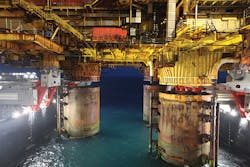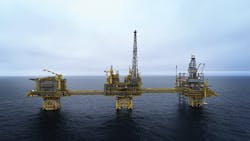Offshore Europe
Pioneering Spirit in heavy-lift mode
Allseas’ Pioneering Spirit proved its ability to lift all topsides great and small over five days in the North Sea last month. The program started in the southern Norway sector with the removal of the 3,800-ton topsides from the QP accommodation platform at the Valhall field, one of the three original installations when production started in 1982. According to Allseas, the castellated cut shape and the pre-installed leg restraints ensured no movement of the topsides prior to the lift. The vessel then transported the structure and a connecting bridge to a nearshore location for onward delivery to Kvaerner’s disposal site in Stord.
The following week the Pioneering Spirit sailed to the UK northern sector to disconnect the 25,000-ton topsides from Shell’s Brent Bravo platform. In this case, the 125-m (410-ft) high, 70-m (229-ft) wide topsides were supported by three 12-m (39-ft) dia. steel-reinforced concrete legs. Preparations included cuts between the legs and topsides, with the structure held in place by shear restraints to prevent lateral movements. The removal operation lasted around four hours, from positioning the vessel around the platform to lift-off, which took only 9 seconds. The vessel then headed south to deliver its load to Able UK’s decommissioning yard in Teesside, northeast England.
Following good experience with single-lift installations of three giant decks for the Johan Sverdrup field complex, Equinor has now booked the Pioneering Spirit to remove and dispose of the 48,000-metric ton (52,911-ton) Statfjord A topsides from the supporting concrete gravity base structure. The platform will shut down for good in 2022, 43 years after first oil from the Statfjord field. To prepare for this quantum leap in single-lifting weight – 20,000 tons above the world record established at Sverdrup - Allseas will take steps to increase the vessel’s lifting capacity.
Chevron winds down UK holdings
Britain’s Oil and Gas Authority (OGA) has granted Equinor and its partners an extension to three licenses containing Rosebank, the deepest-water oil discovery to date in UK waters. The field is 130 km (81 mi) northwest of Shetland, close to the median line with the Faroe Islands, in an area prone to rough seas and in 1,100 m (3,609 ft) water depth. The licensees plan to take a final investment decision on the project by 2022.
According to Hedda Felin, Equinor’s svp for UK and Ireland offshore, there is scope to reduce the development cost of previous operator Chevron’s concept, based around an FPSO. The company sees similarities with other current harsh environment projects in its portfolio, notably Johan Castberg in the Barents Sea and Bay du Nord offshore Newfoundland.
Chevron exited Rosebank last year as the first step in a full-scale sell-off of its North Sea area interests. In May, the company finally agreed to a $2-billion deal with Ithaca Energy, a subsidiary of Israeli conglomerate Delek Group. Ithaca gains 2P reserves of around 225 MMboe and operatorship of the Alba, Alder, Captain, and Erskine fields in the UK central North Sea and other field interests. The package will lift Ithaca’s UK production to 80,000 boe/d, second only to Chrysaor in the league of UK offshore producers. For the time being Chevron retains a 19% stake in the BP-operated Clair oilfield west of Shetland, but Wood Mackenzie said a wholesale UK departure looks increasingly likely as the company seeks to consolidate its US onshore plays.
Earlier, Chrysaor had cemented its position by agreeing to pay ConocoPhillips $2.675 billion for its UK offshore portfolio, which includes operatorship of the J-Block and Britannia gas-condensate hubs in the central sector. The 280 MMboe of proven and probable reserves delivered around 72,000 boe/d last year.
ConocoPhillips re-develops Tor
No signs of itchiness on ConocoPhillips’ part concerning its other North Sea stronghold, the Ekofisk area offshore southern Norway which started producing in 1971. The company has awarded TechnipFMC an EPCI contract for the Tor II development, 13 km (8 mi) northeast of the Ekofisk field center, covering supply and installation of a subsea production system, umbilicals, and rigid flowlines. TechnipFMC said its integrated EPCI approach would allow first oil to flow sooner than would have been the case under a traditional project execution model. Tor came onstream in 1978 through a combined wellhead/processing platform. Operations ceased in 2015, and the facility is due to be removed by 2022, according to the Norwegian Petroleum Directorate.In the UK central North Sea Total started up the HP/HT Culzean gas-condensate field ahead of schedule last month and over 10% below the budget agreed by previous operator Maersk and its partners. The location is in block 22/25a, 230 km (143 mi) from Aberdeen. Development included six wells and three bridge-linked platforms, with gas exported through the CATS pipeline to the UK grid, and condensate stored on an FSO for delivery to shuttle tankers. Total is now the UK’s biggest gas producer, accounting for 18% of daily consumption and with stakes in two further probable developments at nearby Glengorm and the operated Glendronach discovery west of Shetland. •

